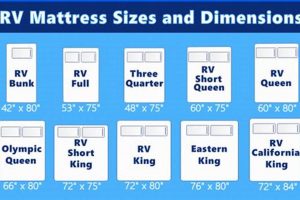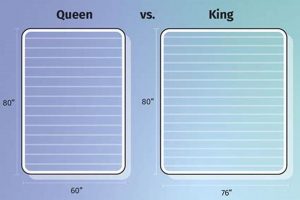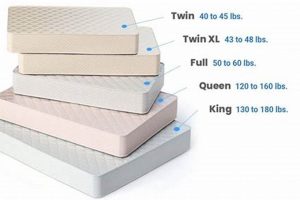A table displaying the dimensions of king-size mattresses is a tool used to provide precise measurements, typically including width and length, of various king mattress types. This chart often differentiates between standard king, California king, and sometimes split king options. For example, a typical king mattress may measure 76 inches wide by 80 inches long, while a California king will measure 72 inches wide by 84 inches long.
Understanding mattress measurements facilitates informed purchasing decisions and ensures compatibility with bed frames, bedroom layouts, and bedding accessories. Historically, standardized mattress sizes evolved to accommodate varying body types and spatial requirements, contributing to improved sleep comfort and optimized bedroom design. Such a resource offers a convenient method for comparing dimensions and making appropriate selections.
The subsequent sections will delve into specific king mattress dimensions, discuss variations in size across manufacturers, and provide guidance on selecting the appropriate mattress dimensions for individual needs and circumstances.
Effective utilization of dimensional data is crucial when considering a king-size mattress. The following tips offer guidance on employing such information for optimal decision-making.
Tip 1: Measure Bedroom Space Accurately: Prior to reviewing a king mattress dimension guide, measure the bedroom’s available space. Account for other furniture and ensure adequate room for movement.
Tip 2: Consider Bed Frame Compatibility: Verify that the chosen mattress size is compatible with the existing or intended bed frame. Frame dimensions must align with mattress specifications to ensure proper support.
Tip 3: Differentiate Between King and California King: Note the distinction between standard king and California king dimensions. California king mattresses offer additional length, suitable for taller individuals, but are narrower than standard king mattresses.
Tip 4: Account for Bedding Availability: Ensure that bedding, such as sheets and comforters, is readily available in the selected mattress size. Bedding designed for one king size may not fit another.
Tip 5: Consider Split King Options: Explore split king mattresses, which consist of two separate twin XL mattresses, if individual sleep preferences or adjustable bed frames are a consideration.
Tip 6: Check Mattress Height: Take into account the mattress’s height, especially when combined with the bed frame, to determine the overall bed height. This can affect ease of getting in and out of bed.
Tip 7: Understand Manufacturer Variations: Recognize that slight variations in dimensions may exist across different mattress manufacturers. Always consult the manufacturer’s specifications for precise measurements.
By adhering to these guidelines, consumers can leverage dimensional information to make informed decisions, ensuring a comfortable and suitable sleeping arrangement.
The concluding section will summarize key considerations and offer final recommendations for selecting the optimal king-size mattress.
1. Standard King Size
The standard king size mattress represents a fundamental element within any king mattress dimension guide. Its prevalence establishes a baseline against which other king-size variations, such as the California king or split king, are compared. A resource presenting mattress dimensions invariably includes the standard king, typically measured at 76 inches in width and 80 inches in length. Omission of this standard would render the guide incomplete and diminish its utility for consumers seeking size comparisons.
The dimensional data for standard king mattresses directly influences purchasing decisions. For instance, individuals with bedrooms of moderate size might prioritize the standard king due to its balance of width and length. Conversely, those with smaller rooms may consult the dimension guide to assess whether the standard king exceeds spatial constraints. Furthermore, bedding manufacturers rely on these established dimensions to produce accurately sized sheets, comforters, and other accessories. Deviations from the standard dimensions necessitate specialized bedding, potentially increasing costs and limiting consumer choice.
In conclusion, the standard king size is not merely a dimension within a mattress chart; it serves as a reference point and an essential data point that underpins informed decision-making across the mattress industry. Challenges arise when manufacturers deviate from these standardized dimensions, creating confusion for consumers. Clarity and consistency in presenting these measurements are crucial for optimizing consumer satisfaction and ensuring seamless integration of the mattress with bed frames and bedding.
2. California King Size
The California king size represents a specific dimension set within a comprehensive king mattress size chart. Its dimensions, typically 72 inches in width and 84 inches in length, differentiate it from the standard king and other variations. The chart is incomplete without this dimension, as it caters to a specific demographic: individuals requiring additional length. The inclusion of the California king within the chart acknowledges the existence of alternative preferences and needs beyond the standard dimensions. Omission would result in a diminished utility for individuals seeking precise information to accommodate taller statures or specific bedroom layouts. For instance, an individual exceeding six feet in height may prioritize a California king to prevent discomfort associated with feet extending beyond the mattress edge. Similarly, a bedroom with a longer, narrower configuration may better accommodate the elongated shape of a California king.
The availability of the California king size within a dimensional resource directly influences purchase decisions and bedroom aesthetics. Understanding its specific measurements enables informed choices regarding bed frame selection, bedding acquisition, and overall room planning. For example, selecting a bed frame designed for a standard king with a California king mattress will lead to an improper fit and potential structural instability. Likewise, standard king-size sheets will not adequately cover a California king mattress. Furthermore, an understanding of these dimensions allows for optimization of bedroom layout, ensuring adequate space for movement and a visually balanced arrangement. A bed frame of the appropriate scale ensures both mattress support and aesthetic proportion within the room.
In summation, the California king’s dimensions are indispensable within a comprehensive mattress chart. Its inclusion offers practical information to consumers with specific spatial or physical requirements. Without this specification, t
he chart becomes limited and fails to address the diverse needs of potential purchasers. Therefore, acknowledging the California king variant within the wider context is crucial for informed decision-making and optimized sleep ergonomics.
3. Split King Option
The split king option represents a notable variation within the landscape of king-size mattresses, necessitating inclusion in a comprehensive mattress dimension chart. This configuration, effectively two twin XL mattresses placed side-by-side, introduces unique considerations for space planning and functionality.
- Individualized Comfort and Motion Isolation
The primary advantage of a split king lies in its capacity to accommodate differing sleep preferences. Each side of the bed can utilize a different mattress firmness, catering to individual needs. Furthermore, the separation of the two mattresses minimizes motion transfer, reducing sleep disturbance caused by a partner’s movements. This impacts the dimensions within the chart, as bedding needs to be selected with the split configuration in mind; standard king sheets are not appropriate.
- Adjustable Bed Frame Compatibility
The split king configuration is frequently paired with adjustable bed frames. Each side of the bed can be independently adjusted, allowing for personalized positioning for reading, watching television, or alleviating medical conditions. A king mattress size chart must acknowledge this application, as frame dimensions must precisely match the two twin XL mattresses to ensure proper support and functionality. Variations in mattress height can affect the smooth operation of the adjustable frame.
- Spatial Considerations and Room Layout
While the overall dimensions of a split king mattress mirror those of a standard king (76 inches wide by 80 inches long), the presence of two separate mattresses can influence room layout considerations. Maneuvering two individual mattresses can be more challenging than a single king mattress, particularly in tight spaces. The mattress dimension chart assists in assessing the feasibility of fitting the split king within the designated bedroom space, taking into account access points and other furniture.
- Bedding Selection and Maintenance
The split king option necessitates specialized bedding arrangements. While a standard king-size comforter or duvet cover can be used, individual twin XL sheets are required for each mattress. This can lead to increased costs and necessitates a more involved laundering process. The mattress size chart serves as a reminder of these considerations, prompting consumers to budget for appropriate bedding and assess the practicalities of maintaining two separate sets of sheets.
The split king configuration presents both advantages and practical considerations that are vital within a comprehensive king mattress size chart. By acknowledging these nuances, consumers can make informed decisions that align with their specific sleep needs and spatial constraints. Failure to account for these factors can result in compatibility issues and suboptimal sleep experiences.
4. Width Measurements
Width measurements are a fundamental component of any king mattress size chart, directly influencing the suitability of the mattress for specific bedroom dimensions and sleeping arrangements. Inaccurate or absent width specifications render the chart incomplete and potentially misleading. The width measurement, typically expressed in inches, defines the lateral space occupied by the mattress, determining whether it will comfortably fit within a designated area without obstructing movement or access to other furniture. For instance, a standard king mattress, with a width of 76 inches, requires a bedroom spacious enough to accommodate this dimension while leaving adequate clearance around the bed. Conversely, a California king mattress, narrower at 72 inches, might be preferable in rooms with limited width.
The selection of a mattress based on width measurements has practical implications for shared sleep. A sufficient width allows each sleeper ample personal space, minimizing disturbances caused by movement or temperature variations. Furthermore, the mattress width influences the size and type of bedding required. Standard king mattresses necessitate king-size sheets and blankets, whereas split king configurations demand twin XL-size bedding for each side. Discrepancies between the actual mattress width and the dimensions listed on the chart can lead to ill-fitting bedding and reduced sleep comfort. Manufacturers who adhere to standardized width measurements contribute to a more predictable and satisfactory consumer experience.
In conclusion, width measurements are an indispensable element of a king mattress size chart, serving as a critical factor in bedroom space planning, shared sleep considerations, and bedding compatibility. The accuracy and clarity of these measurements directly impact the ability of consumers to make informed purchasing decisions. Challenges arise when manufacturers deviate from established standards, underscoring the importance of a reliable and consistent dimensional reference point.
5. Length Measurements
Length measurements form an integral part of any king mattress size chart. These measurements dictate the overall footprint of the mattress, impacting compatibility with bed frames, suitability for individuals of varying heights, and the overall aesthetic of the bedroom. A reliable mattress dimension guide accurately specifies length, providing consumers with essential data for informed decisions.
- Height Accommodation and Sleep Comfort
Mattress length directly affects the comfort of sleepers, particularly taller individuals. A mattress with insufficient length can lead to discomfort and disrupted sleep as limbs extend beyond the mattress edge. For example, a California king mattress, with its extended length of 84 inches, caters specifically to individuals exceeding six feet in height. Mattress size charts highlight these length variations, enabling consumers to select an option that accommodates their physical needs. Inadequate length consideration can lead to chronic sleep deprivation and musculoskeletal strain.
- Bed Frame Compatibility and Support
Length measurements are critical for ensuring compatibility between the mattress and the bed frame. A mattress that exceeds or falls short of the frame’s specified length can result in inadequate support, potential damage to the mattress, and an unstable sleeping surface. Dimensional guides provide the necessary information to ensure proper alignment between mattress and frame. Improper fit can accelerate mattress wear and compromise the structural integrity of the bed frame. A secure fit also prevents the mattress from sliding or shifting during sleep.
- Room Layout and Spatial Optimization
The length of a king mattress influences the layout of the bedroom and the efficient use of available space. Measuring the room and consulting mattress size charts allows for strategic placement of the bed, leaving sufficient room fo
r movement and other furniture. For instance, a room with limited length might necessitate careful consideration of the California king’s longer profile to avoid overcrowding. Failing to account for mattress length can lead to a cramped and uncomfortable living environment. Proper spatial planning contributes to a more functional and aesthetically pleasing bedroom. - Bedding Fit and Aesthetic Considerations
Length measurements also impact the fit of bedding, such as sheets, blankets, and comforters. Bedding designed for a standard king mattress may not adequately cover a California king, and vice versa. A dimensional guide provides the necessary information to select bedding that drapes properly and maintains an aesthetically pleasing appearance. Ill-fitting bedding can detract from the overall look of the bed and create practical inconveniences. Accurate length specifications contribute to a cohesive and visually appealing bedroom design.
These considerations emphasize the importance of accurate and readily available length measurements in a king mattress size chart. Such details are essential for making informed purchasing decisions that optimize sleep comfort, ensure proper bed frame compatibility, facilitate efficient room layout, and contribute to a visually pleasing bedroom environment.
6. Height Considerations
Height considerations are intrinsically linked to the utility of a king mattress size chart. The overall height of a mattress, encompassing both its core construction and any additional layers, significantly affects accessibility and comfort for individuals of varying statures. This dimension dictates ease of entry and egress from the bed, influencing the suitability of a particular mattress for different individuals.
- Impact on Bed Accessibility
The height of a king mattress, combined with the bed frame, determines the overall bed height. For individuals with mobility limitations or shorter stature, an excessively high bed can pose challenges when getting in and out. Conversely, a bed that is too low may require excessive bending, potentially exacerbating back problems. A king mattress size chart should ideally provide height specifications to allow individuals to assess accessibility based on their personal needs. For instance, elderly individuals or those with joint pain may prioritize lower-profile mattresses for ease of use.
- Influence on Sheet Fit and Bedding Aesthetics
Mattress height dictates the necessary depth of fitted sheets. Shallow-pocket sheets may not adequately cover thicker mattresses, leading to slippage and discomfort. Conversely, excessively deep-pocket sheets can bunch up and create an uneven sleeping surface. The mattress dimension guide assists in selecting appropriate bedding dimensions to ensure a snug and aesthetically pleasing fit. Luxury mattresses often have significant height, mandating the use of deep-pocket sheets.
- Compatibility with Bed Frames and Headboards
The height of a mattress influences its visual proportion relative to the bed frame and headboard. An excessively tall mattress may obscure a headboard, diminishing its aesthetic impact. Conversely, a low-profile mattress may appear dwarfed by a tall headboard. A mattress dimension guide aids in achieving a balanced and visually harmonious bedroom arrangement. For example, platform beds often require lower-profile mattresses to maintain a sleek and modern aesthetic.
- Effect on Perceived Room Size and Space
The overall height of the bed, influenced by mattress height, can impact the perception of room size. A very tall bed can visually dominate a smaller bedroom, making it feel cramped. Lower-profile mattresses can create a sense of spaciousness and airiness. The mattress size chart, when considered in conjunction with bedroom dimensions, facilitates informed choices that optimize the use of space and create a comfortable environment. Careful height selection can make a small room feel larger and more inviting.
The multifaceted impact of mattress height underscores its significance within the context of a king mattress size chart. Height considerations extend beyond mere dimensions, influencing accessibility, aesthetics, and the overall user experience. By providing accurate height specifications, mattress charts empower consumers to make informed decisions that align with their individual needs and preferences.
Frequently Asked Questions Regarding King Mattress Dimensions
This section addresses common inquiries concerning king mattress dimensions, providing precise information to aid in informed purchasing decisions.
Question 1: What are the standard dimensions of a king mattress?
A standard king mattress typically measures 76 inches in width and 80 inches in length. These dimensions provide ample space for two adults.
Question 2: How does a California king mattress differ in size from a standard king?
A California king mattress measures 72 inches in width and 84 inches in length. While narrower than a standard king, it offers an additional four inches in length, catering to taller individuals.
Question 3: What is a split king mattress, and what are its dimensions?
A split king mattress consists of two twin XL mattresses placed side by side. Each twin XL measures 38 inches in width and 80 inches in length, resulting in the same overall dimensions as a standard king.
Question 4: Are mattress dimensions consistent across all manufacturers?
While standard dimensions exist, slight variations may occur between manufacturers. Consulting the manufacturer’s specifications prior to purchase is advisable to ensure accurate fit with bed frames and bedding.
Question 5: What factors should be considered when determining appropriate mattress height?
Mattress height influences ease of entry and egress from the bed and affects the visual proportion of the bed frame. Individual physical needs and aesthetic preferences should be considered.
Question 6: How does mattress size impact bedding selection?
Mattress size dictates the required dimensions of sheets, blankets, and comforters. Selecting bedding specifically designed for the mattress size ensures a proper fit and optimal comfort.
In summary, a thorough understanding of king mattress dimensions, including width, length, and height, is essential for informed purchasing decisions and overall sleep satisfaction.
The subsequent section will provide a concluding overview of the key considerations discussed throughout this article.
Conclusion
The preceding analysis has illuminated various facets of the king mattress size chart. Dimensions, encompassing width, length, and height, directly influence suitability for diverse bedroom layouts and individual needs. Standard king, California king, and split king options each present distinct characteristics that demand careful consideration. Discrepancies in dimensional data across manufacturers underscore the need for meticulous verification prior to purchase.
Accurate application of a king mattress size chart fosters informed decision-making, ensuring compatibility with bed frames, bedding, and spatial constraints. Neglecting these dimensions can lead to suboptimal sleep experiences and unnecessary expenditure. Continued diligence in maintaining and disseminating standardized measurements remains crucial for
consumer confidence and marketplace efficiency.




![Best Soft King Mattress [Guide] For Restful Sleep Organic & Natural Mattress Buyer’s Guide: Non-Toxic Sleep Solutions Best Soft King Mattress [Guide] For Restful Sleep | Organic & Natural Mattress Buyer’s Guide: Non-Toxic Sleep Solutions](https://mattressworldpa.com/wp-content/uploads/2025/07/th-8174-300x200.jpg)


